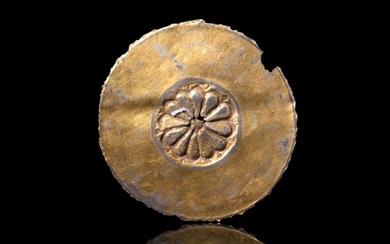Hellenistic Gold and Silver Diadem
4th-2nd century BC. A gold diadem section composed of compact gold laurel leaves, arranged in horizontal rows, finely incised floral details to the surface; a central ornament of a quatrefoil, with crescentic pendant and two bead breloques, two gold fastening rings with jade and almandine stones. Cf. the diadem has parallels with the tiara of golden leaves, from the same period, preserved in the National Archaeological Museum of Taranto, Italy, coming from one of the rich Tarentine necropolises of the Hellenistic period, see Moscati, S., (ed.), Gli ori di Taranto, Genova, 1975. 31.70 grams, 16cm (6 1/4"). Property of a London lady; from her family collection formed in the 1970s. Wreaths had special significance within Greek culture. They signified dignity, merit, high status, and respect. The winners of the Olympic Games were awarded wreaths fashioned from sacred olive branches tied with a white woollen ribbon, and the winners of the Isthmic Games were awarded wreaths from pine branches or fresh celery. Outstanding speakers, poets, playwrights and actors were crowned with branches of laurel- a tree dedicated to Apollo, the patron god of arts (hence the word 'laureate'"). A myrtle wreath was worn by those who spoke at the National Assembly, as a sign of fulfilling their civic duty. A wreath of golden oak or laurel leaves served as a symbol of royal power (such a wreath was found in the tomb of Philip II, father of Alexander the Great"). Wreaths were also an obligatory headdress at feasts and during the holidays. These festival wreaths were made of fragrant herbs and flowers, and roses and violets were particularly popular. For feast wreaths, ivy was often used, since it was believed that it prevented intoxication. Wreaths were used by men and women alike.
Condition Report: Fine condition.
View it on
Sale price
Estimate
Time, Location
Auction House
4th-2nd century BC. A gold diadem section composed of compact gold laurel leaves, arranged in horizontal rows, finely incised floral details to the surface; a central ornament of a quatrefoil, with crescentic pendant and two bead breloques, two gold fastening rings with jade and almandine stones. Cf. the diadem has parallels with the tiara of golden leaves, from the same period, preserved in the National Archaeological Museum of Taranto, Italy, coming from one of the rich Tarentine necropolises of the Hellenistic period, see Moscati, S., (ed.), Gli ori di Taranto, Genova, 1975. 31.70 grams, 16cm (6 1/4"). Property of a London lady; from her family collection formed in the 1970s. Wreaths had special significance within Greek culture. They signified dignity, merit, high status, and respect. The winners of the Olympic Games were awarded wreaths fashioned from sacred olive branches tied with a white woollen ribbon, and the winners of the Isthmic Games were awarded wreaths from pine branches or fresh celery. Outstanding speakers, poets, playwrights and actors were crowned with branches of laurel- a tree dedicated to Apollo, the patron god of arts (hence the word 'laureate'"). A myrtle wreath was worn by those who spoke at the National Assembly, as a sign of fulfilling their civic duty. A wreath of golden oak or laurel leaves served as a symbol of royal power (such a wreath was found in the tomb of Philip II, father of Alexander the Great"). Wreaths were also an obligatory headdress at feasts and during the holidays. These festival wreaths were made of fragrant herbs and flowers, and roses and violets were particularly popular. For feast wreaths, ivy was often used, since it was believed that it prevented intoxication. Wreaths were used by men and women alike.
Condition Report: Fine condition.




